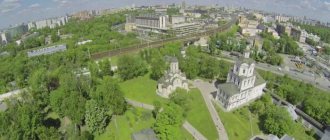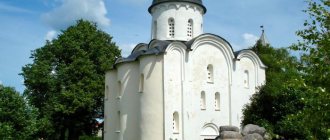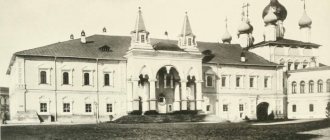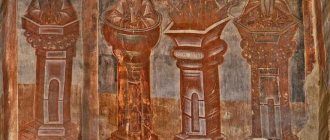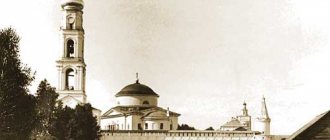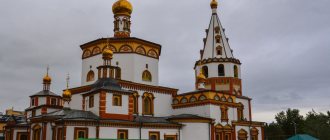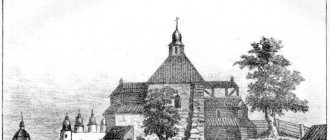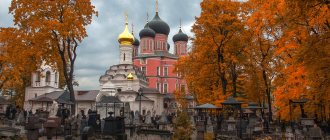I give you useful information about holidays and Orthodox events...
Yuryevsky Monastery in Veliky Novgorod is one of the oldest Russian monasteries, which in the past was the spiritual heart of the Novgorod Republic, and today it is considered a monastery of the Russian Christian Church for men. The temple is located 5 km from the Novgorod regional center and is located near Lake Ilmen on the banks of the Volkhov River. It should also be noted that until 1918 the temple had the status of a 1st class community.
History of origin
Over its long history of existence, St. George's Cathedral has undergone a lot of devastation and destruction. However, the majestic structure has not lost its spiritual value in the Orthodox world.
St. George's Monastery
Initially, a wooden church stood on the site of St. George's Cathedral. In 1119, under the initiative of Grand Duke Mstislav I Vladimirovich, construction of a fundamental building made of stone began. The work lasted for 11 years. On July 12, 1130, when the cathedral was completely built, it was consecrated. God's House was named after the great commander George the Victorious. The consecration ceremony was conducted by Bishop John.
Before the revolution
The beginning of the 17th century was a difficult time for the Orthodox Church. St. George's Cathedral and the entire St. George's Monastery suffered from the Swedes, who did not hesitate to dig up and rob graves. It is reliably known that in 1614, Swedish soldiers carried out robberies throughout Veliky Novgorod, including the holy monastery. They destroyed the grave of Prince Fyodor. What is surprising is that the remains of the prince had a completely preserved human appearance.
In the 19th century, the daughter of Count Alexei Orlov-Chesmensky, Anna, began work on the restoration of the St. George Church. It is this period that is called “golden” for the St. George’s Monastery. On the territory of the holy monastery, the cathedral was restored, and three new buildings and a bell tower were built.
The walls were built from massive stone blocks and bricks
After the revolution
The post-revolutionary period was especially difficult. According to historical information, in 1922 St. George's Cathedral lost its icons, liturgical vessels and the silver shrine of St. Theoktista. The latter was sent for smelting.
In 1929, the monastery was completely closed. The period of looting lasted until 1935. For unknown reasons, they even destroyed the majestic seven-tiered iconostasis. This happened during the “architectural restoration” of the building.
In 1991, the Yuriev Monastery was returned to the Novgorod diocese. The holy monastery was in a pitiful state: not a single icon survived in the dilapidated church of God. Since 1995, St. George's Cathedral has gone through several stages of restoration. To date, the temple has only partially regained its grandeur and significance.
In 1992, Yuryev Monastery was included in the UNESCO heritage list. However, according to local residents, the holy monastery requires repairs and significant financial investments. About a meter of the walls of the St. George Church has already gone underground. The process of destruction is observed at a rapid pace.
Important information
Architectural features
In size, St. George's Cathedral is similar to the St. Sophia Church of the Novgorod Kremlin. The foundation of the building has a cruciform shape. The height of the structure reaches 32 m, width – 18.3 m, length – 26.8 m.
The cross-domed, six-pillar, three-nave temple looks heavy and at the same time impressive. The walls were built from massive stone blocks and bricks. Mixed masonry ensures strength and reliability of the structure. The cathedral is crowned by three chapters, which have an asymmetrical arrangement. The central dome covers the middle cross, the second (middle) is elevated above the square staircase turret, the third (small) balances the other tower.
The roof was roof-like, covered with lead sheets. Over time, it was replaced with a hipped one. The architecture of the building is carefully thought out. The main room, which is intended for worship, is much larger in size. The altar part is visually smaller.
New solutions
Although the choirs of the cathedral are placed quite high, they do not look squeezed under the vaults. The western and eastern parts of the building are not equal in size, as, for example, in similar architectural monuments. In addition, the master, increasing the width of the small naves, which are three times larger than the thickness of the walls, made the eastern one somewhat shorter.
In the temple, it is as if there is a subconscious division into the main room intended for worshipers, and a slightly smaller one - the altar.
St. George's Cathedral is as grandiose from the outside as it is from the inside. However, there is a surprisingly equal dimensionality here, manifested in the abundance of identical windows and niches located in belts. In the precision of the composition there is a sense of a kind of academicism, almost unnoticeable due to the asymmetry of the volumetric construction and powerful stonework, not at all constrained by overly strict lines.
Interior decoration
In comparison with the external grandeur, the interior decoration of the temple looks simpler. But at the same time there is no feeling of crampedness and closed space. The central part seems to fly up, heading towards the domes. On the western side there are high choirs that go from the bottom of the walls to the top. It was assumed that this is where the prince and his family would be during services. Initially, there were two chapels in the cathedral: in the name of All Saints and in honor of the Annunciation.
The wall painting is of little value as it was renovated in 1991. It is also impossible to say anything special about the current iconostasis. A primitive partition with icons displayed in one row - such an iconostasis is now typical for the St. George Cathedral in St. George's Monastery in Veliky Novgorod. The primary iconostasis, more than 20 m high, was destroyed by the atheists of the 20th century.
One of the surviving treasuries of the temple are fragments of paintings from the early 12th century, which are located on the inner walls of the dome. Small round windows allow soft light to fall onto the tranquil wall art. There is a staircase of 50 steps leading to the choir, and 43 steps to the dome.
Interior decoration
The current iconostasis
Fragments of painting from the early 12th century
Burials and shrines
The burials of the St. George Church have a sad history. As already mentioned, in the period from 1614 to 1616, Swedish grave diggers destroyed the graves of the holy monastery. The enemies discovered two stone sarcophagi, one of which contained a female skeleton, and the second contained chaotically scattered bones of a teenager. Presumably these are the burial places of the holy Prince Theodore Yaroslavich and his mother, Princess Theodosia-Efrosinia.
Pilgrims are attracted to the shrines of the temple, including:
- relics of Saint Theoktistus of Novgorod;
- icon of St. George the Victorious;
- iconographic face of Alexander Nevsky's mother;
- a piece of rock to which the king's daughter was chained;
- Shroud embroidered with gold thread of Prince Dmitry Shemyak.
Relics of Saint Theoktistus of Novgorod
The role of the temple
The status enjoyed by the Yuryev Monastery in the Novgorod diocese was exceptional. Founded by leading Russian princes, for several centuries it was revered as the first in importance among local spiritual centers. At one time it was even called the Yuryev Lavra.
Since the end of the twelfth century, St. George's Cathedral has served as the final resting place not only of Russian princes, but also of the abbots of the monastery and Novgorod mayors.
In 1198, both sons of Prince Yaroslav were buried here - Rostislav and Izyaslav, who was the godson of the Monk Varlaam. In June 1233, the remains of Theodore Yaroslavich, the elder brother of Alexander Nevsky, were also brought here. Eleven years later, in May 1224, their mother, Princess Theodosia Mstislavna, also died. Several years before her death, she accepted monasticism, so in the Yuryev Monastery she was known as Euphrosyne. The princess was buried near the southern wall, next to her eldest son.
Tips for visitors
St. George's Monastery and the temples and shrines located on its territory attract millions of pilgrims. Some come to admire the grandeur of the once main spiritual center of the Russian Orthodox Church, others come to pray, ask for help and favor from the Almighty.
How to get there
The monastery is located in the city of Veliky Novgorod. The address of the monastery is: Yuryevskoye Highway, 10. You can get here either by public or by your own transport. Minibuses No. 7 and 7a depart from the station every day, which will take you almost to the very walls of the holy monastery. You should get off at the final stop, which is called “Yuryevo”.
If you have your own vehicle, the road to the monastery takes much less time - no more than 15-20 minutes. You need to follow Troitskaya Street, which turns into Yuryevskoe Highway.
Schedule of services
St. George's Cathedral is open to the public every day except Wednesday. Worship services are held according to the following schedule:
- 7:45 – fraternal prayer service;
- 8:00 – liturgy;
- 18:00 – evening service.
On honored dates, festive services are held. For example, on the day of remembrance of the Great Martyr George the Victorious (May 6), the schedule of services may be changed. You can check the service time on the official website of the St. George's Monastery.
Divine services in the temple are held daily.
St. George's Cathedral in Veliky Novgorod is a unique spiritual and architectural monument of Russia. Believers from different parts of Russia and other countries come here to see the greatness of God’s house, to feel its strength and power, to be cleansed of sinful thoughts and to receive grace.
If you find an error, please select a piece of text and press Ctrl+Enter.
Men's St. George's Monastery, brief history
The temple itself was founded in 1030, which, according to legend, was founded by Yaroslav the Wise (during the baptismal ceremony he received the name George, pronounced in Russian as Yuri), that is, it was this fact that served as the name for the future monastery.
In the chronicles, the first mention of the community was back in 1119, so for several centuries it was referred to as the Lavra and among other shrines it was the first in importance. In the 15th century, the monastery was the largest and most prosperous Orthodox feudal lord. In the 20th century (around 20-30), the church community was closed and subsequently plundered.
The monastery was also affected by the Second World War, where military units of the Spanish-German invaders were located during the fighting. In the post-war years, the temple became a place for many people to live, while on its territory there were buildings of a technical school, a museum, a post office, shops and more. The final return of the monastery to the Russian Christian Church took place in 1991.
Dear brothers and sisters! We invite you to visit the unique resource https://www.slovo-pomoshi.ru/. With its help, you can convey your aspirations to St. Petersburg churches, chapels, monasteries, and also contact the righteous at the place of their burial. We will write a note ourselves, take it to the temple and send you a photo report by email. Turning to God with the help of prayers has helped many people overcome grief, regain health and the joy of worldly life.
Useful articles:
THE TALE OF THE MOON RAY This fairy tale was written by a boy living in a hospice. Mishka, he is 12 years old. Since last fall, he has been rejected by doctors. He wrote it for a school literary competition, but it's not that important. It is important that he wants his fairy tale to be read. To feel - who needs it and who wants it... When Mishka... Read more
ABOUT THE POWER OF PSALMES 26 and 90. “Well, so I’ll tell you what! You once told me that the enemy was shooting his arrows at you. Do not be afraid! None of them will touch you, don’t be afraid of any rubbish: rubbish will remain rubbish. Just take my advice as a rule, listen: read morning and evening before your prayer... Read more
About the prayer of the last Optina elders Archpriest Andrei Tkachev about prayer for those who do not have time to pray. A believer must pray, nothing new here. He must want to pray, which is more difficult, because not everyone wants to. You need to force yourself to pray. But the rule is long, time is short, and we get tired, and we suffer, and... Read more
MIRACLE OF FAITH Sasha was in Chechen captivity - 5 years; for two years he was not fed; tested hand-to-hand combat techniques on it; he was shot several times, shot almost point-blank, but they couldn’t shoot him!!! In 1995 - the first Chechen war. I was the commander of the assault group, and with... Read more
